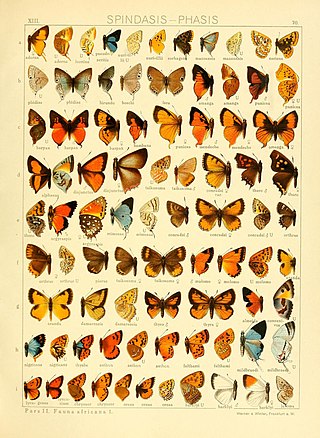
Axiocerses is a genus of butterflies in the family Lycaenidae. The species of this genus are found in the Afrotropical realm.

Axiocerses tjoane, the eastern scarlet, common scarlet or scarlet butterfly, is a butterfly of the family Lycaenidae. It is found in East and southern Africa.
Axiocerses croesus, the dark-banded scarlet, is a butterfly of the family Lycaenidae. It is found in the Eastern Cape, west up to Port Elizabeth and into Kwazulu-Natal.
Axiocerses coalescens, the black-tipped scarlet, is a butterfly of the family Lycaenidae. It is found in wooded savanna areas in Gauteng, Mpumalanga, Limpopo and north-western South Africa and further to the north.

Axiocerses amanga, the bush scarlet, is a butterfly of the family Lycaenidae. It is found in Sub-Saharan Africa.

Axiocerses harpax, the common scarlet, is a butterfly in the family Lycaenidae.
Axiocerses callaghani, the Callaghan's scarlet, is a butterfly in the family Lycaenidae. It is found in south-western Nigeria and Cameroon. The habitat consists of forests.

Axiocerses bambana is a butterfly in the family Lycaenidae. It is found in the Democratic Republic of the Congo, Tanzania and Zambia. The habitat consists of moist woodland.
Axiocerses nyika is a butterfly in the family Lycaenidae. It is found in Malawi and Zambia. The habitat consists of hills with stunted, shrubby vegetation, at altitudes between 1,980 and 2,290 meters.
Axiocerses heathi is a butterfly in the family Lycaenidae. It is found in north-western Zambia.
Axiocerses melanica is a butterfly in the family Lycaenidae. It is found in Zambia. The habitat consists of moist woodland.
Axiocerses karinae is a butterfly in the family Lycaenidae. It is found in Malawi.
Axiocerses styx is a butterfly in the family Lycaenidae. It is found in north-eastern Tanzania. The habitat consists of lowland forests at altitudes between 600 and 1,000 meters.
Axiocerses kiellandi is a butterfly in the family Lycaenidae. It is found in south-central Tanzania. The habitat consists of forests at altitudes between 350 and 500 meters.
Axiocerses bamptoni is a butterfly in the family Lycaenidae. It is found in south-western Malawi. The habitat consists of montane forests.
Axiocerses collinsi is a butterfly in the family Lycaenidae. It is found in the coastal forests of Kenya. The habitat consists of coastal forests.
Axiocerses maureli is a butterfly in the family Lycaenidae. It is found in Ethiopia.

Axiocerses punicea, the rainforest scarlet or Punic scarlet, is a butterfly in the family Lycaenidae. It is found in Kenya, Tanzania, Malawi, Zimbabwe, Mozambique and possibly the Democratic Republic of the Congo. The habitat consists of forests.
Axiocerses argenteomaculata is a butterfly in the family Lycaenidae. It was described by Arnold Pagenstecher in 1902. It is found in Burka, Ethiopia.
Axiocerses jacksoni is a butterfly in the family Lycaenidae. It was described by Stempffer in 1948. It is found in Ethiopia, Somalia and northern Kenya.



